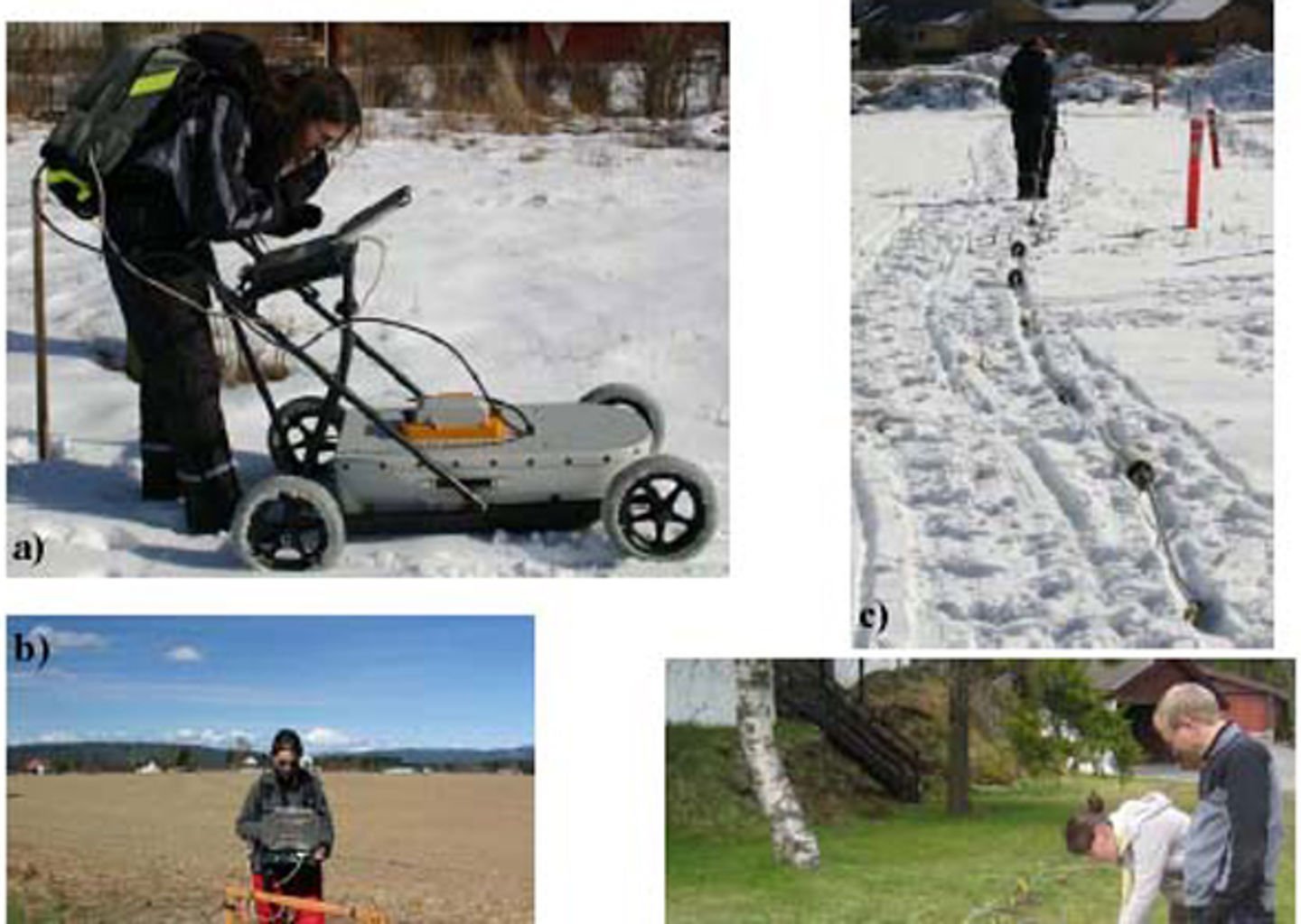- NGI /
- Projects /
- ICG - International Center for Geohazards /
- SP 11 - Geophysics for Geohazards
SP 11 - Geophysics for Geohazards
Geophysics is needed to give information about underground structures, especially for spatial mapping.

ICG introduced "Themes" in 2005 for topics going across several projects and for which coordination was necessary, for several reasons
- better use of human and equipment resources, and better communication
- spreading of competency between the projects
- identification of research topics and project work for students
At ICG all projects are multi-disciplinary, covering geology, geotechnics, and geophysics. In many cases, techniques that were used in one project, and possibly improved, are useful in other projects as well. It is therefore important to keep an overview of what is going on in each project to better cover the need in other projects.
Geophysics is needed to give information about underground structures, especially for spatial mapping. ICG Theme 1 is dedicated to the use of "Geophysics in Geohazards" assessments, on land and offshore.
Many geophysical techniques can be applied, depending on the type of structures to study
- seismic reflection and refraction
- microseismic monitoring
- Ground Penetrating Radar (GPR)
- electrical methods
- electromagnetism
- magnetism
- gravimetry
Of all available techniques, only those able to give useful information to geologists and geotechnical engineers faced with geohazard assessment will be studied within ICG.
Objectives
The scientific objectives within the Geophysics for Geohazards Theme are to:
- improve the integration of different data types (geological, geotechnical, and geophysical) in geohazard investigations by maintaining an open dialog between the different experts and working closely with the relevant ICG projects
- identify specific research areas for geophysics, taking into account the actual experience of the partners and their own available technology (seismic modeling and monitoring at NORSAR, S-source and Seabed Logging at NGI, resistivity and extensive field practice at NGU, GPR expertise at UiO, etc).

Figure 1. a), b) GPR equipment (UiO), c) Resistivity equipment (UiO), d) Seismic equipment (UiO)
- work with students, in order to teach them how to use geophysics, without them needing to be geophysicists, but to give them sufficient knowledge of the technology to avoid mistakes in the acquisition of the data and interpretation of the results
- work on specific case studies illustrating various aspects of the use of geophysics for geohazards assessment
- promote publishing at conferences and in peer-reviewed journals within geophysics. It is indeed very important to help gather experience internationally in order to gain from earlier experiments and to further develop the technology.
National and international cooperation
ICG aims at establishing national and international cooperation with relevant partners and projects. Up to now, active contacts have been established with
- University of Tromsø, UiT, Norway, gas hydrates
- Norwegian Defence Research Institute, FFI, Marine Department, geoacoustics
- Joseph Fourier University, Grenoble, France, LIRIGM/LGIT, land geophysics
- 'Ecole et Observatoire des Sciences de la Terre', EOST, Strasbourg, France
- Leibniz Institute for Applied Geosciences, GGA, Hannover, Germany
- University of Lund, Sweden, resistivity
- University of Århus, Denmark, Geophysics and Geodynamics, resistivity
- Moscow State University (MSU), remote sensing and debris flow, Russia
- Several universities in the USA and one in Australia, within an NSF-funded project for geohazards
Contacts exist also with the National Oceanographic Centre, Southampton (NOCS) in offshore geohazards, and with the Swiss Federal Institute of Technology (ETH), Institute of Geophysics, Zürich (glacier and permafrost hazards).
Education
Master students of the "Environmental Geology" course at UiO/NTNU are following various courses in environmental geophysics and getting in touch with geohazards problems. Students are also involved in fieldwork.
Acknowledgments
We thank all ICG partners for their participation and interest, in providing both equipment and expertise. We would like especially to thank Wenche Jensen, leader of the "Sogn Hagekoloni", for permission to test equipment in the garden. Many thanks also to Helge Oppsahl for letting us measure in his field at Moreppen.
Staff
- Isabelle Lecomte NORSAR, Theme Coordinator - geophysics
- Svein-Erik Hamran UiO contact person - geophysics
- Andy Kaab, UiO contact person - remote sensing, geography
- Maarten Vanneste NGI contact person - geophysics
- Jan Steinar Rønning NGU/NTNU contact person - geophysics
Students
- Harald Iwe, Ph.D. student, UiO/ICG/NGI, 2004-2009
- Anne-Laure Bouillon, Dipl.Eng. Geophysics trainee, University of Strasbourg, 2005
- Inger-Lise Solberg, Ph.D. student, NTNU, ICG/NGU/NVE grant, 2004-2007
- Jean-Sébastien L'Heureux, Ph.D. student, NTNU, ICG/NGU grant, 2006-2008
- Mael Daleau, Dipl.Eng. Geophysics trainee, University of Strasbourg, 2006
- Isabelle Thollet, Dipl.Eng. Geophysics trainee, University of Strasbourg, 2006
- Shana Volesky, summer fieldwork, Vassar College, 2007
- Alexandra Guy, summer fieldwork, EOST, University of Strasbourg, 2007
- Guilhem Douillet, summer field work, EOST, University of Strasbourg, 2007
- Emanuelle Fréry, summer internship/field work, EOST, University of Strasbourg, 2007
- Eugene Morgan, Master Thesis, Tufts University, 2007/2008
- Karl Magnus Nielsen, Master Thesis, University of Oslo, 2008
- Marianne Holst Nielsen, Master Thesis, University of Oslo, 2008
- Guillaume Sauvin, summer internship, University of Strasbourg, 2008
- Florian Köllner, internship, University of Leipzig, 2009
- Guillaume Sauvin, Dipl.Eng. Geophysics trainee, University of Strasbourg, 2009